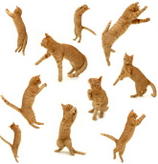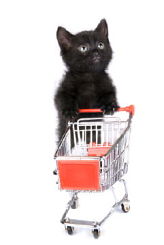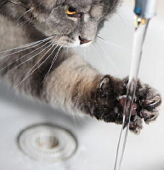Cat Health Water...a forgotten nutrient
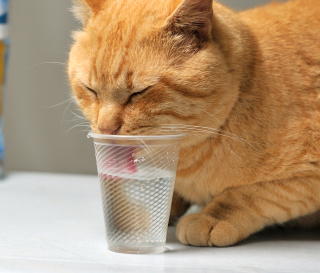
Cat health water...most conscientious pet food shoppers take care to be sure that their cats are getting all the nutrients they require for proper health. Dry cat food labels are checked for the protein and fat levels listed to see that they are appropriate for the life stages of the cats. The AAFCO criteria for "complete and balanced" cat foods does not include feline health water.
Consider this...an animal can last weeks to months without any food at all, depending on the amount of fat and muscle in the body. For some nutrients, such as calcium, an adult cat can continue on a deficient diet for months and sometimes years before clinical signs are observed. However, go for more than a couple of days without this vital fluid and they can be in serious trouble.
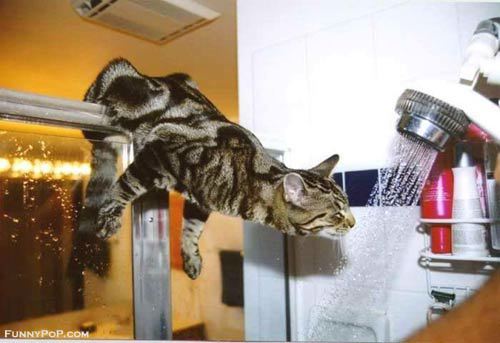
Cat health water is important because it acts as a "universal solvent", which means that most chemicals in the body must dissolve in it in order to interact properly. Not enough fluid, and these biochemical processes come to a halt. Nutrients can't be digested and brought to the cells, waste products can't be transported and removed from the body properly, heat generated from the body can't be dissipated, and organ function is impaired.
The body attempts to conserve fluid by making urine more concentrated and reabsorbing more fluid from the feces, but eventually these efforts fail and death becomes imminent. This might sound scary but you've probably not thought about it so seriously. So...make sure your cat gets enough if it...cat health water is also the cheapest of the nutrients.
Cats essentially are desert animals. This is evident from their ability to concentrate urine more highly than most other mammals, such as dogs and humans. Despite these adaptations to help them survive in arid conditions, cats do not need any less cat health water than other species for their bodies to function properly. Individual fluid requirements depend on many factors, including life stage, activity level, and environmental conditions such as air temperature.
The rule of thumb used by vets to estimate fluid needs is that an animal requires one milliliter (ml) of fluid for every food calorie consumed. For an average adult cat, this means a daily minimum requirement of 250-350ml (about 9-12 fluid ounces).
This doesn't mean the cat has to drink this amount every day. A portion of this requirement is met from normal metabolic processes in the body. The breakdown of protein, carbohydrates and fats in the body produces the fluid in the chemical reaction. Depending on the diet, cats may also receive a significant portion of their daily needs from the food itself.
For example, canned cat food typically contains 78% water, so a six ounce can of cat food might provide as much as 130 ml. If a cat is fed canned foods only, it might need to consume very little. However, dry food contains much less moisture, so if any dry food is offered, the need for other sources of fluids goes up.
There are many types of cat health water; tap, well, hard, soft, bottled, purified, spring, mineral and distilled, to name just a few. One form is not better than the other with few exceptions. People may choose to drink bottled or use a filter/purifier on their tap for reasons of taste or safety concerns. Since the quality and safety available from the vast majority of taps in the United States is good, it is acceptable for your cat.
"Hard"... means there's a relatively high amount of dissolved minerals in it, such as calcium and magnesium. These minerals prevents soaps from sudsing fully and can leave stains or deposits on clothes or fixtures. The amount and type of dissolved minerals varies greatly region to region, so no hard and fast rules can be made.
Usually, the amount of minerals does not contribute significantly to the cat's total daily intake compared to what's taken in by the food, and poses no concerns for the healthy animal. The amount of magnesium is far lower than found in cat food, even in "low magnesium" varieties. Many people use a softening system so these excess minerals are rarely a factor in their cat's diet.
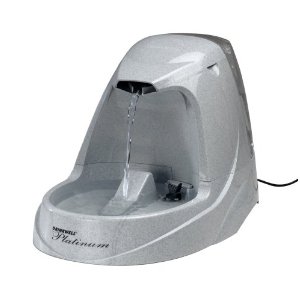
"Softened"... can present problems under some conditions. Many softening systems use a "sodium-cation exchange" process, which replaces minerals such as calcium and magnesium with sodium. The amount of sodium is minimal compared to that found in cat foods and is not a factor for healthy cats. However, for those humans or cats with some types of heart disease, this additional sodium can be a negative factor in attempts to achieve a restricted sodium intake.
"Distilled"...A vet may recommend use of distilled for cats with certain medical conditions. The distilling process essentially means it is boiled and the steam recollected, leaving behind the minerals. While in many cases this extreme may not be necessary, each case is unique. Unless specifically directed by your vet, there's no good reason to use anything other than what is normally offered to the rest of your household.
Providing cat health water to your cat is a simple concept although there are a number of bowls and other contraptions available to accomplish this function. Some cat bowls contain compartments to add ice packs to keep the fluid cool, while others use a small pump to create movement. While these concepts may have a bit of merit, giving your cat fresh, clean water that is always available is the most important.
It should be dumped and refreshed at least once a day, even if it doesn't appear that the cat is drinking much. Any scraps, hairs, etc. that appear in the bowl would be cleaned out when noticed. It should be placed in an area where the cat can easily reach it, but out of any heavy traffic areas or a place where it has to worry about people or other animals interrupting its drinking experience. Do not place it near the cat's litter box.
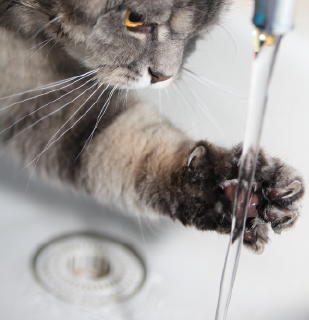
Substituting milk, which is mostly water, is not necessarily a good idea. Although most cats like the taste, the vast majority of adult cats are lactose intolerant.
This means they lack the enzyme in their intestines to break down the lactose or milk sugar. The undigested sugar is then fermented by the bacteria lower in the intestinal tract, causing digestive upsets and diarrhea.
There are low and reduced lactose milks available but since milk contains other substances that can cause spoilage when left open at room temperature, and can attract insects....plus make your cat fatter...it is not a recommended cat health water fluid substitute.
If you notice your cat drinking out of the toilet, sink or other undesignated area, don't blame the cat. He is simply trying to tell you that you're not doing your job of providing cat health water effectively.
However, that being said...my cat Max had fresh water available and still drank from the toilet intil I got a cat drinking fountain which had water circulating all the time. Changing the filter every couple of weeks takes a little longer than just washing a bowl but it's keeping him away from the toilet.
Related Articles......
Return From Cat Health Water to Cat Health Homepage
Having trouble finding what you need? Cat Health Index & Site Map
OR
Do you have a question to ask?...Questions
OR
Do you have a cat story to share?...Simply click here to go to that page!
Copyright@2010-2020 All rights reserved.Cat-health-detective.com
This website is information only. Consult a veterinarian for medical assistance

"Like Us" on Facebook
or...
"Like Us" here

